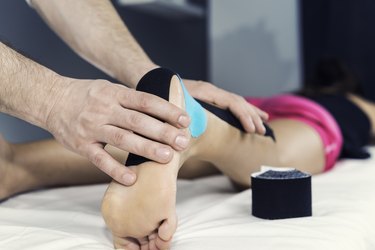
If you've had a hamstring injury in the past, it might be more vulnerable to injury in the future, especially when placed under stress. To help prevent future hamstring problems, protect your thigh while jogging, walking, hiking or engaging in other sports.
Increasing hamstring support by wrapping your thigh with athletic tape prior to performing these activities will give your muslce the additional support it needs to avoid potential injuries.
Video of the Day
Video of the Day
Read more: The Advantages of Strong Hamstrings
Ice and Prep
If you just injured your hamstring, ice the muscle to get the swelling down before bandaging it. Wrap an ice pack in a towel and alternate 20 minutes on and 20 minutes off, until the swelling has gone down.
Use an athletic pre-wrap on your hamstring before you start using athletic tape. The pre-wrap will help the athletic tape stick in place better during your activity and help you remove the athletic tape with a bit more ease when the exercise is over. Pre-wrap also helps to prevent skin irritation.
Start to Wrap
Take the athletic tape and start wrapping your hamstring. Start about 1 1/2 inches above your your knee and head up to your groin, stopping about 3 inches below the groin.
Wrap the tape firmly, but do not cut off circulation in your leg. Remember you are going for a run or competing, so you can't inhibit proper circulation. The key word is snug. You want support from the athletic tape, but you still want to be able to move your leg comfortably.
Cautions and Aftercare
If you have concerns about the tape being too tight and you've received proper training in its use, wrap with kinesio tape (in which case you omit the pre-wrap). Kinesio tape — which gets its name from kinesiology (the study of the mechanics of body movement) — also benefits the circulatory and neurological systems.
Elevate your leg after competing in a sporting after wrapping your hamstring. Take off the wrap and elevate your leg for at least 20 to 30 minutes.
Read more: Should You Stretch a Pulled Hamstring?
Tip
If you feel any sharp pain, stop competing or running. You will feel pressure and that's OK, but don't continue to participate if you feel pain.
Hamstring Compression Sleeve
Although wrapping your hamstring can be beneficial, it can also be a tedious process. If you have ongoing hamstring issues or want a more convenient option to wrapping, consider using a hamstring compression sleeve.
Although it's an older study, an October-December 2005 article published by the Journal of Athletic Training examined the effect of neoprene thigh sleeves during exercise. Researchers found that use of the sleeve during exercise increased skin temperature both during and after exercise. This is beneficial as increased tissue temperature helps to promote healing.
The study also showed that in addition to increased skin temperature, the temperature of the muscle itself stayed elevated for 15 minutes after exercise with the use of the neoprene sleeve. Increased muscle tissue temperature has been shown to increase flexibility in the muscle, which can also help prevent future injury during exercise.